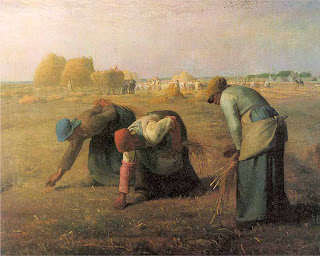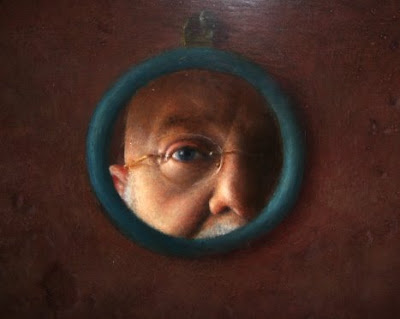
Robert Brawley
"Cruising the Edge"
1999, oil on panel, 18" x 24"

Brancusi, "Bird in Space" 1923

Andrew Wyeth, "Christmas Morning" 1944

Rodin, "The Prodigal Son" 1884

Gustave Dore, "White Rose" 1857
 William Blake
William Blake, "The Angel of the Divine Presence clothing Adam and Eve with skins" 1803

William Blake, "A Negro Hung Alive by the Ribs to a Gallows" 1796

Bruce Naumann "The True Artist Helps the World by Revealing Mystic Truths" 1967

Ernst Fuchs, "Adam and Eve in front of the Tree of Knowledge" 1984

Millet, "The Gleaners" 1857

Courbet, "The Origin of the World" 1866
"Painting from nature is not copying the object; it is realizing one's sensations."
Paul Cézanne
"The aim of art is to represent not the outward appearance of things, but their inward significance."
Aristotle
"The essence of painting has actually always been to make the universal plastically perceptible through colour and line."
Mondrian
“I am very proud of being slavishly true to life.”
Rodin
“What they call 'abstract' is in fact the purest realism, the reality of which is not represented by external form but by the idea behind it, the essence of the work”
Brancusi
Introduction
I set out or write about the New Realism in painting, or the “Integral realism” (since integral is the current avant gard.) However, like any good exploration, my research gave rise to outpourings of new ideas and unexpected complications. I had to change my topic to “Reexamining Realism,” because I discovered that what is “real,” from an avant gard or integral perspective, depends upon the stage or altitude of consciousness in the individual. There is a deep and wide spectrum of real worldviews, and therefore, real worlds, each with their own form of “realism.” Nietzsche: "There are no facts, only interpretations." And one's interpretation of reality depends upon what kind of structure of consciouses one has to work with.
William Blake puts it thus: “The tree which moves some to tears of joy is in the eyes of others only a green thing that stands in the way. Some see nature all ridicule and deformity... and some scarce see nature at all. But to the eyes of the man of imagination, nature is imagination itself."
Put yet another way, “selfishness” only has meaning after “the self” is defined; “realism” only has meaning once “the real” is defined. What happens when the Self is pushed to include all of creation, and the Real is pushed to infinity?
To make my meanderings more meaningful, or, for the more serious student of Art History and Art Theory, you will want to consult Michael Garfield’s interview with Ken Wilber,
"Art Beyond Irony."Background"Realism" the concept arose in the 19th century as a tool to help guide art and society away from social imbalances and mythic chains. It was to help revive truthfulness. The landscape was, at that time, a radical protest against the Church. However, today, “Realism,” if it has any meaning at all, is not confined to that original context or function. It might retain it’s impulse to be free from style, but that also has multiple meanings we will explore later.
Courbet: "The essence of realism is its negation of the ideal."
Ever since Millet painted those gleaners, the West’s idea of “Realism,” a term coined by Courbet, has been the stark, immediate reality delivered to us by our senses, not referencing past myths or past arts, not romanticizing or fantasizing, but instead reflecting only what is real in the present.
But what if “what is real in the present” for the artist is infinity? Or the ineffable feeling of falling in love? Or a mystical vision? William Blake never said he was depicting fantasies. He said he conversed with angels in his garden and they sometimes had six toes on each foot (see painting above). Michelangelo saw the mythic landscapes filling the minds of everyone around him, and he painted that real, internal world. He never said he was painting rational, physical reality, but he was definitely painting a mythic one.
Rodin,
in a famous interview, got angry with the reporter who insisted that Rodin doesn't reproduce nature as it really is. “You are mistaken. I do reproduce it exactly as it is.”
“Are you not compelled to change it slightly?” the interviewer asked.
“Under no circumstances. I would have cursed myself if I had to do it!” He then explained that it is impossible for a model to stay completely still, to hold a pose for a long time, and so the sculptor of nature must include the movement, as well as the soul and spirit of the model, which is, after all, part of the reality of the living being.
“I see the whole truth, not only its surface.”
Brancusi, a student (briefly) of Rodin, made art history in 1927 when U.S. Customs decided that the proper classification for his highly polished, curving brass column “Bird in Space,” was ‘metal’, not ‘art.’ Thus, he had to pay $4,000 to import it, even though ‘art” is duty free. Up to that point, art was officially only “that which imitates the natural world.” However, artists and art lovers rushed to Brancusi's defense, he won the case, got his money back, and the US had to redefine art. The court’s final decision: objects which portray abstract ideas (in this case, "flight"), may be classified as art. Brancusi: “When you see a fish you don't think of its scales, do you? You think of its speed, its floating, flashing body seen through the water... If I made fins and eyes and scales, I would arrest its movement, give a pattern or shape of reality. I want just the flash of its spirit.”
As we can see, sometimes an abstract “thought” is more realistic than the a solid “thing”. This is one way to begin to see why ‘Abstraction” can actually be more realistic than traditional “Realism.” Reality, after all, moves and decays and is made of energy, light, and sound. Seeing clearly, there are no solid forms anywhere. Our senses trick us into thinking there is, but in reality, there isn’t. Even the Buddha said that suffering is caused by clinging to things that are bound to change. It is therefore reasonable that, in order to free us from the illusion of solidness, “realism” must move into a “more realistic” stance.
“Vision, or imagination, is a representation of what actually exists, really and unchangeably. Fable, or allegory, is formed by the daughters of Memory.” William Blake
The Universals“A landscape painting represents or depicts states of nature, an abstract painting represents or depicts states of mind. Both are, in that sense, representational, because both the sensorimotor worldspace and the mental worldspace are real and existing landscapes.” -Ken Wilber
Ask any artists what they are trying to depict, and chances are they will say they are trying to depict or communicate something real. Some will even say that they are trying to depict something universally real. However, in this postmodern day in age, it's commonly accepted that "there are no universal truths" (except for that statement…whoops!). Less extreme is the idea that there are some universal truths, but there are more relative truths, and we need to be very careful before we assert anything as "universally true."
Relative truths are true only for one individual culture or worldview. Universal truths are true for everyone. I can hear the REM song "Everybody Hurts!" In 1967, when neon-light artist Bruce Naumann constructed his great truism "The true artist helps the world by revealing mystic truths,” he meant universal truths, spiritual truths. However, there is a spectrum of universal truths, from "We all have ten toes" to "We all feel pain' to "We all have Buddha Nature." What is catholic, or universal, or spiritual, deals with the shared human spirit, as well as the shared human history. In art (and in meditation practices) these universals are elevated in importance, for depicting them helps dissolve the boundaries between us (and open the door of our compassion/liberation). Even if the artist is depicting the existential truth that "All we know and have is ourselves," that is a universal condition. We ALL live and die alone. No matter which direction we go, ascending to transcendental unity or descending to existential alienation, universal truths shine forth, from 'we are all sinners" to "we are all gods."
Therefore, let's consider realism to be that which depicts universal truths. But if we go there, then most all art rushes to the table, because all of it essentially claims to depict the universals.
"I think a true form ought to suggest infinity. The surfaces ought to look as though they went on forever, as though they proceeded out from the mass into some perfect and complete existence." Brancusi.
In many ways, the “abstract” artists, who were trying to get at what is universally real, were pointing to reals that “naturalist” realists simply could not. Mandrian, Rothko, Brancusi, these people were pointing to pure emotions, pure forms, infinity, essence. They were extremely interested in realism. They weren’t fucking around with half-reals or fictions. Rothko himself said “I’m not an abstractionist. I’m not interested in the relationship of color or form or anything else. I’m interested only in expressing basic human emotions: tragedy, ecstasy, doom, and so on.”
So what? All art is realism? Even the most abstract? Realism can have no meaning anymore!
That leaves us with a less than interesting talk, and so, I will instead point us to one aspect of realism that I, being a painter and magician, find particularly fascinating: Illusionism.
Formally, traditional realism is Illusionism. It's tricking the viewer to perceive a 3-d object (and that object could simply be space). It's like a hologram; it's a hoax, a dream, which makes it even more realistic since Reality also appears to be a hologram that isn't quite there like we perceive it to be.
"Reality is merely an illusion, albeit a very persistent one."
Albert Einstein
One more thing"Fantastic Realism," "Magical Realism," and "Psychological Realism" are not the same as Surrealism because they are not just simply "dream time" depictions of nonsense and irrationality. They might appear to be surreal or dreamy, but they actually depict the mystical, alchemical, symbolic, spiritual, which are not below rationality, but beyond it.










































